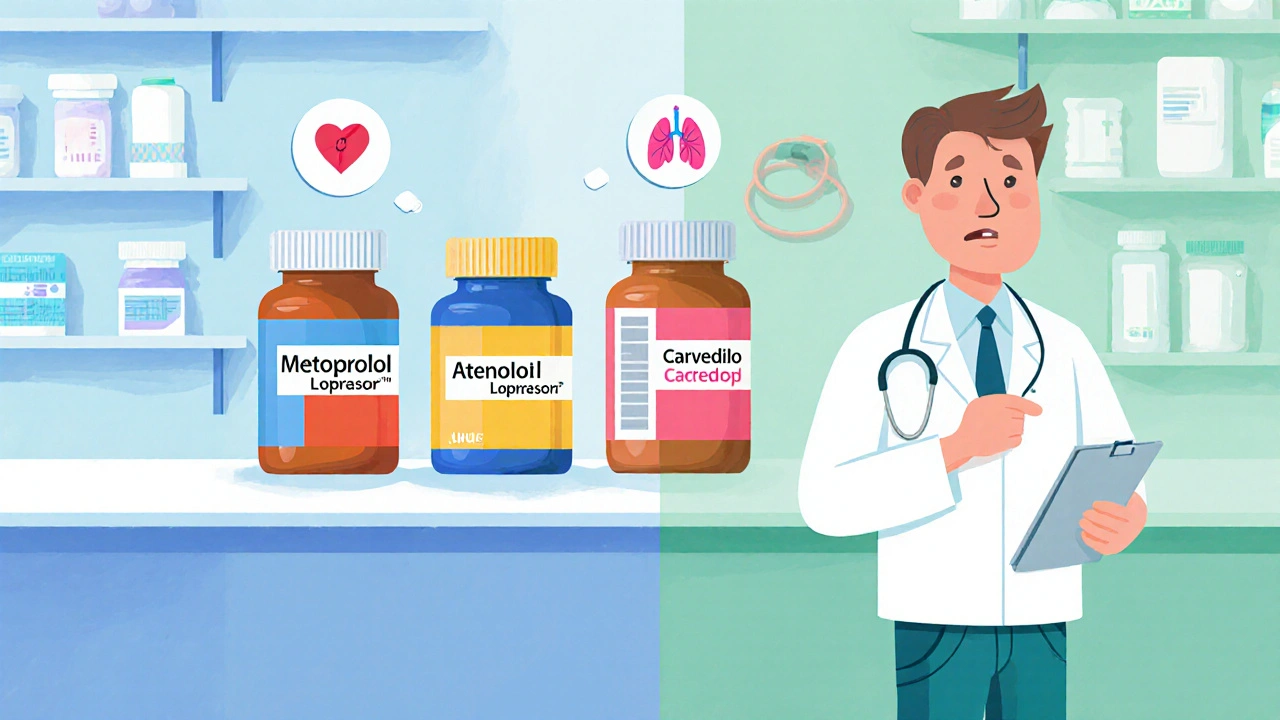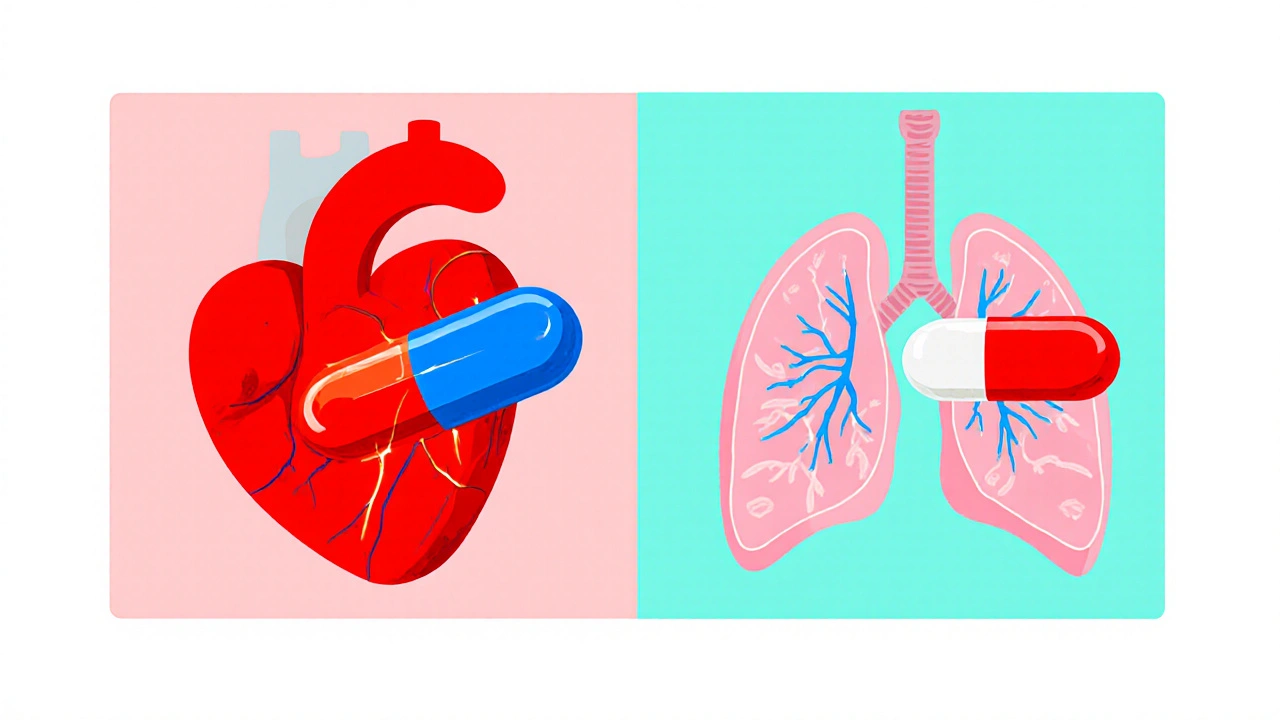Lopressor (Metoprolol) vs Common Alternatives: A Practical Comparison
 Oct, 17 2025
Oct, 17 2025
Medication Selection Tool
Find Your Best Medication Match
Answer these questions to see which medication might be best for your specific health situation.
Recommended Medication
Key Considerations
Cost Estimate
Ever wondered if there’s a better pill than the one your doctor wrote for you? If you’ve been prescribed Lopressor and are hearing names like Atenolol or Carvedilol floating around, you’re not alone. Below we break down what makes Metoprolol tick, how its rivals stack up, and what to look for when deciding which heart‑friendly drug fits your life.
What is Lopressor (Metoprolol)?
Metoprolol is a beta‑1 selective blocker that slows the heart, lowers blood pressure, and eases the workload on the heart muscle. Marketed under the brand name Lopressor, it was first approved by the FDA in 1978 and quickly became a go‑to for hypertension, angina, and certain arrhythmias.
Because it zeroes in on beta‑1 receptors in the heart, Metoprolol tends to cause fewer breathing‑related side effects than non‑selective blockers. That’s why many clinicians start here when they need to tame a racing heart or high blood pressure.
How Metoprolol Works and When It’s Used
- Mechanism: Blocks adrenaline’s signal at beta‑1 receptors, reducing heart rate and contractility.
- Primary indications: High blood pressure (hypertension), chest pain due to coronary artery disease (angina), and after‑heart‑attack (post‑MI) management.
- Typical dosing: 25mg to 200mg daily, taken with or without food.
- Half‑life: About 3‑7hours (extended‑release forms last longer).
If you’re wondering whether Metoprolol is right for you, ask yourself: Do I need a drug that mainly targets the heart without affecting lungs too much? If yes, Metoprolol is often a solid pick.
Key Factors to Compare When Looking at Alternatives
Before we dive into the rival drugs, keep these comparison points in mind. They’ll help you sort through the details without getting lost.
- Receptor selectivity: Does the drug hit only beta‑1 (heart) or both beta‑1 and beta‑2 (lungs, blood vessels)?
- Typical dose range: Some drugs need a tiny tablet, others a larger one - this affects convenience and cost.
- Half‑life and dosing frequency: Longer half‑life means fewer daily pills.
- Side‑effect profile: Fatigue, cold hands, dizziness, or breathing issues - which ones matter to you?
- Price and insurance coverage: Generic versions are cheap, brand names can be pricey.
- Additional benefits: Some blockers also help with migraine prevention or anxiety.
Atenolol - The Classic Low‑Dose Contender
Atenolol is a beta‑1 selective blocker similar to Metoprolol but with a shorter half‑life and less lipid solubility. It’s been around since the early 1980s and is often prescribed for hypertension and angina.
- Typical dose: 25mg‑100mg once daily.
- Half‑life: 6‑9hours.
- Key pros: Simple once‑daily dosing, lower risk of CNS side effects (like vivid dreams).
- Key cons: May be less effective for heart‑failure patients; can cause cold extremities.
Carvedilol - The Dual‑Action Powerhouse
Carvedilol is a non‑selective beta blocker that also blocks alpha‑1 receptors, leading to vasodilation and lowered blood pressure. It’s a favorite for heart‑failure management and post‑MI care.
- Typical dose: 6.25mg‑50mg twice daily.
- Half‑life: 7‑10hours.
- Key pros: Improves heart‑failure outcomes, reduces after‑load via alpha blockade.
- Key cons: More likely to cause dizziness and orthostatic hypotension; not beta‑1 selective, so asthma patients need caution.

Propranolol - The Old‑School Non‑Selective Blocker
Propranolol is a non‑selective beta blocker that hits both beta‑1 and beta‑2 receptors, making it useful for tremor, migraine prevention, and performance anxiety. First approved in 1964, it’s one of the most studied heart drugs.
- Typical dose: 40mg‑320mg daily, divided into 2‑4 doses.
- Half‑life: 3‑6hours.
- Key pros: Multi‑purpose (migraine, essential tremor, anxiety).
- Key cons: Higher chance of bronchospasm in asthmatics; must be taken multiple times a day.
Lisinopril - A Non‑Beta‑Blocker Alternative
Lisinopril is an ACE inhibitor that relaxes blood vessels by blocking the conversion of angiotensin I to angiotensin II. While not a beta blocker, it’s often paired with or swapped for beta blockers in hypertension treatment.
- Typical dose: 5mg‑40mg once daily.
- Half‑life: 12hours (active metabolite up to 24hours).
- Key pros: Protective for kidneys, good for diabetic patients, once‑daily dosing.
- Key cons: Can cause a persistent dry cough, rare risk of angioedema.
Side‑by‑Side Comparison Table
| Drug | Receptor selectivity | Typical dose range | Half‑life | Main uses | Common side effects | Average US price (generic) |
|---|---|---|---|---|---|---|
| Metoprolol | Beta‑1 selective | 25‑200mg daily | 3‑7h | Hypertension, angina, post‑MI | Fatigue, cold extremities, bradycardia | $0.15 per tablet |
| Atenolol | Beta‑1 selective | 25‑100mg daily | 6‑9h | Hypertension, angina | Dizziness, cold hands, insomnia | $0.10 per tablet |
| Carvedilol | Non‑selective beta + alpha‑1 | 6.25‑50mg BID | 7‑10h | Heart failure, post‑MI | Dizziness, weight gain, fatigue | $0.20 per tablet |
| Propranolol | Non‑selective beta | 40‑320mg daily | 3‑6h | Migraine, tremor, hypertension | Bronchospasm, fatigue, sleep disturbances | $0.12 per tablet |
| Lisinopril | ACE inhibitor (non‑beta) | 5‑40mg daily | 12h (active metabolite 24h) | Hypertension, heart failure, diabetic nephropathy | Cough, hyperkalemia, angioedema | $0.08 per tablet |
Pros & Cons at a Glance
- Metoprolol: Great for heart‑specific issues, well‑tolerated in most patients; may need multiple daily doses for extended‑release forms.
- Atenolol: Simple once‑daily schedule, fewer CNS effects; less proven in heart‑failure.
- Carvedilol: Dual beta/alpha action helps heart failure; higher chance of low blood pressure and dizziness.
- Propranolol: Versatile for migraine and tremor; not ideal for asthma or COPD.
- Lisinopril: Excellent kidney protection, no heart‑rate slowing; cough can be a deal‑breaker.

How to Choose the Right Medication for You
Pick a drug based on three personal questions:
- What’s my primary health goal? If you need strict heart‑rate control after a heart attack, Metoprolol or Carvedilol are top picks. For pure blood‑pressure lowering without heart‑rate impact, Lisinopril may be smarter.
- Do I have breathing issues? Asthma or COPD patients should steer clear of non‑selective blockers like Propranolol and Carvedilol.
- How sensitive am I to side effects? If cold hands or fatigue bother you, Atenolol’s milder profile might suit you better.
Always talk to your doctor about kidney function, liver health, and other meds you’re taking. A simple blood test can reveal whether a drug’s metabolism will be a problem.
Common Pitfalls and Safety Tips
- Never stop a beta blocker abruptly - sudden withdrawal can cause heart‑rate spikes and chest pain. Taper slowly under medical supervision.
- Watch for drug interactions. NSAIDs, certain antidepressants, and some diabetes meds can blunt the blood‑pressure‑lowering effect.
- Check your blood pressure regularly during the first few weeks. Adjustments are common as your body adapts.
- If you experience persistent cough with Lisinopril, let your doctor know - switching to an ARB (like Losartan) can solve the problem.
Bottom Line
There’s no one‑size‑fits‑all answer. Metoprolol (Lopressor) remains a solid, widely used beta‑1 blocker, but alternatives like Atenolol, Carvedilol, Propranolol, and even non‑beta‑blockers such as Lisinopril can be smarter choices depending on your health profile, lifestyle, and tolerance. Using the comparison criteria above, you can have an informed chat with your clinician and land on the medication that keeps your heart happy without unwanted side effects.
Frequently Asked Questions
Can I switch from Metoprolol to Atenolol on my own?
No. Even though both are beta‑1 blockers, they have different dosing schedules and half‑lives. A doctor should create a taper plan and set a new starting dose for Atenolol.
What makes Carvedilol different from Metoprolol?
Carvedilol blocks both beta receptors and alpha‑1 receptors, which widens blood vessels. That extra alpha action helps people with heart failure but also raises the chance of dizziness.
Is the dry cough from Lisinopril serious?
The cough is usually harmless but annoying. If it persists for more than a few weeks, ask your doctor about switching to an ARB (angiotensin receptor blocker) which doesn’t cause the cough.
Can Propranolol help with performance anxiety?
Yes. Because it blocks the physical “fight‑or‑flight” response, a low dose taken an hour before a public‑speaking event can calm tremor and rapid heartbeat.
Do beta blockers affect exercise performance?
They can lower maximum heart rate, so you might feel you can’t push as hard. Most doctors advise adjusting the dose or timing if you’re an avid athlete.
Alexis Howard
October 17, 2025 AT 12:16Metoprolol isn’t the only game in town.
Darryl Gates
October 21, 2025 AT 03:32Actually, Metoprolol does have a solid track record for post‑MI patients, but it’s worth scanning the table you posted. If you’re after a once‑daily pill with fewer CNS effects, Atenolol might fit the bill. Keep an eye on how your kidneys handle the dose and ask your doc about generic pricing.
Kevin Adams
October 24, 2025 AT 18:49Behold the saga of beta‑blockers-a tale of heartbeats silenced and arteries humbled!
Metoprolol stands like a stoic knight, its beta‑1 selectivity a shield against pulmonary foes; yet Carvedilol wields a double‑edged sword, conquering vascular resistance whilst courting dizziness.
One must ask: does the heart crave the gentle touch of a selective blocker or the fierce embrace of a non‑selective champion?
In the grand theater of pharmacology, each drug plays its part, and the audience is our pulse.
Katie Henry
October 28, 2025 AT 09:05Esteemed colleagues, it is imperative to approach this decision with both scientific rigor and personal resolve. A thorough assessment of comorbidities, such as asthma or renal insufficiency, will guide the optimal selection. Should you prioritize cardiovascular remodeling, Carvedilol offers documented mortality benefits in heart‑failure cohorts. Conversely, if minimizing bronchospasm risk is paramount, Metoprolol remains a prudent choice. Let us advance with confidence, armed with evidence and patient‑centered goals.
Joanna Mensch
November 1, 2025 AT 00:21Behind the glossy drug brochures lies a hidden agenda of profit‑driven giants, steering patients toward patented brands while obscuring cheap generics. The data on Metoprolol’s long‑term safety is filtered through layers of corporate control, making it difficult to trust the headlines. Consider the possibility that alternative pathways are being suppressed to keep the market churned.
Nickolas Mark Ewald
November 4, 2025 AT 15:38That’s a good point about the industry influence. In practice, many clinicians start with Metoprolol because it’s well‑studied and covered by insurance. If cost is a concern, checking the pharmacy’s generic price can save a lot. Also, ask about side‑effect monitoring during the first weeks.
Chris Beck
November 8, 2025 AT 06:54American doctors should stop bowing to foreign pharma lobbyists and prescribe home‑grown meds like Metoprolol that are made in the USA. The imported alternatives are just a ploy to weaken our healthcare sovereignty. Stick with the domestic stuff and you’ll keep the dollar at home.
Sara Werb
November 11, 2025 AT 22:11WTF you think that “home‑grown” excuse isn’t just a PR stunt??? The FDA is in the pocket of big pharma!!! They push Carvedilol as the miracle drug while hiding the truth about Metoprolol’s side effects!!! Nobody tells you the real stats-don’t be a sheep!!
Winston Bar
November 15, 2025 AT 13:27Honestly this whole comparison feels like a marketing fluff piece. All these tables and pros/cons just blur the line between real patient experience and pharma hype. I’d rather skip the pills and try lifestyle changes.
Russell Abelido
November 19, 2025 AT 04:43I hear you and many folks feel overwhelmed when faced with a wall of drug data. It’s easy to get lost in the jargon while your heart races with anxiety. Remember that every medication is a tool, not a destiny. Metoprolol, for example, has helped countless patients survive heart attacks. Yet its side‑effects like fatigue can make you feel like you’re dragging through mud. On the other hand, Atenolol’s once‑daily dosing feels like a breath of fresh air for busy lives. Carvedilol’s dual action can be a boon for heart‑failure sufferers, though the dizziness it brings may feel like the ground shifting beneath you. Propranolol’s versatility is a double‑edged sword, offering migraine relief while threatening bronchospasm in asthmatic lungs. Lisinopril’s kidney‑protective charm can be nullified by a nagging cough that never quits. The key is to match your personal health story with the drug’s profile, not the other way around. Talk openly with your doctor about what matters most to you-whether it’s staying active, avoiding cold hands, or keeping a stable mood. A gradual taper, if you ever need to stop a beta‑blocker, can spare you a rebound surge that feels like a sudden panic attack. Monitoring your blood pressure at home gives you real‑time feedback and a sense of control. And don’t forget the power of diet, exercise, and stress‑relief techniques that work hand‑in‑hand with any prescription. In the end, the best choice is the one that keeps your heart beating steady and your spirit unshaken 😊
Steve Holmes
November 22, 2025 AT 20:00Interesting point about lifestyle, but I’m curious-how do you think the half‑life differences actually affect adherence in real‑world settings? For patients who struggle with twice‑daily dosing, a longer‑acting formulation could improve compliance dramatically. Have you seen any data on that?
Tom Green
November 26, 2025 AT 11:16Great discussion, everyone. To sum up, weigh the drug’s selectivity, dosing frequency, side‑effect profile, and cost against your personal health goals. If you’re unsure, schedule a follow‑up with your clinician to review labs and possibly trial a low dose before committing. Stay proactive and keep sharing experiences here.